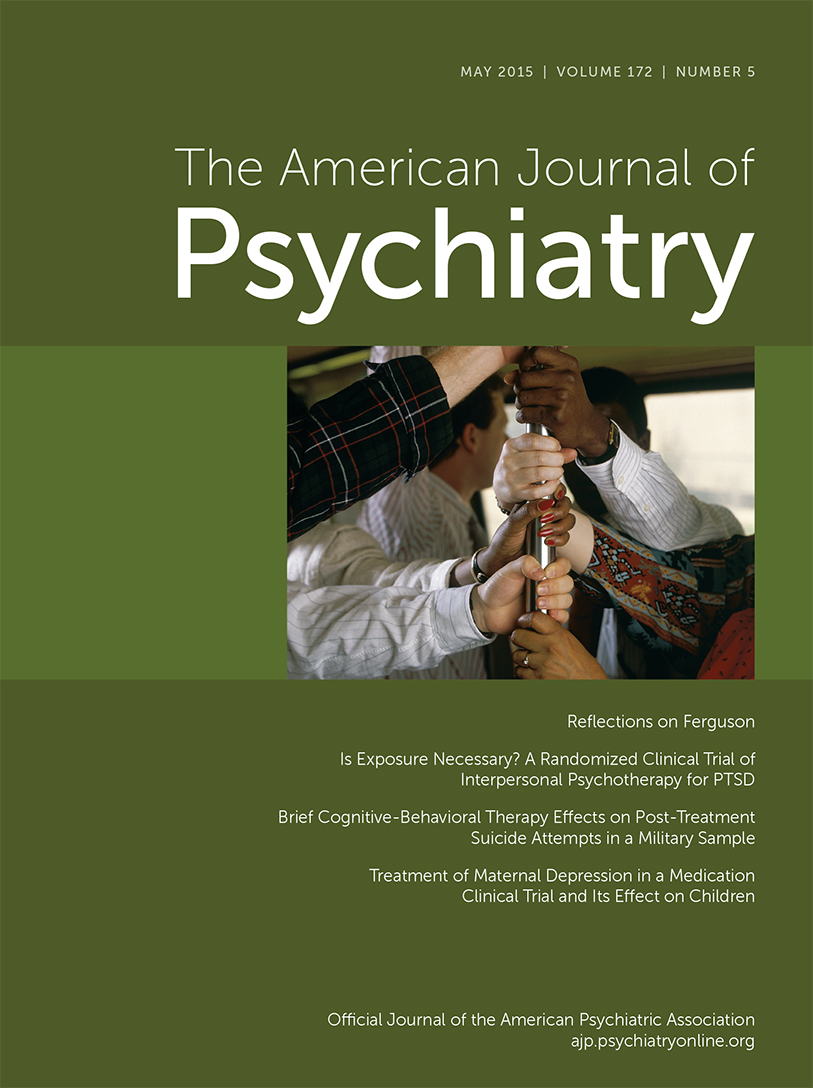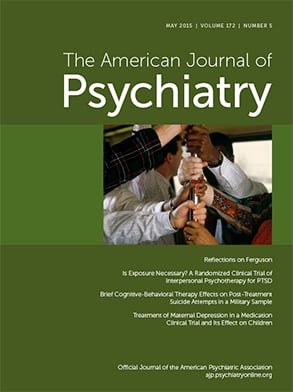The Decade of the Brain has yielded impressive advances in neuroimaging and now promises new insights into complex networks and genetics. Yet, the pipeline of novel neuropsychiatric drugs, as well as drugs for other fields, has dried to a trickle. The number of new drugs approved by the U.S. Food and Drug Administration per billion U.S. dollars (inflation-adjusted) spent on research and development has halved roughly every 9 years (
1). What drugs have been developed consist predominantly of “me-too” agents; this outcome, in turn, has generated considerable anguish and debate about the reasons for the failure in new drug discovery, as well as pathways to remediate this. We are now at a juncture with three potential paths ahead.
The first path is the intellectual highway, one grounded in a cogent pathophysiological foundation upon which a hypothesis can be formulated that engages and tests a single clear target (
2). Such target engagement of the critical pathophysiological element, if it happens to be the right target, should ameliorate the symptomatic and biomarker manifestations of the disorder using a clinical trial to test the hypothesis. The success of the clinical trial will then serve as proof of principle of the pathophysiological foundation and, contingent on the efficacy and pragmatics of the intervention, could lead to a validated therapy. This paradigm incorporates the essence of the “bench to bedside” translational model. This model has the appeal of intellectual rigor, due scientific process, and linear consequential deductive methodology. Despite being the preferred path of industry and academia, and the path most invested in, it has not succeeded in delivering many truly novel therapies in psychiatry, and it has proven rather more successful in creating biosimilars. Nutt (
3) has gone so far as to argue that “there have been no conceptual treatment breakthroughs based on neuroscience insights.” This linear target approach has also had limited success in other branches of medicine, even for disorders for which pathophysiology is better established (
1). A challenge is that this linear path can be less linear and predictable than one might expect. For example, the development of imatinib for chronic myelogenous leukemia (and now other cancers) took 40 years of seemingly unrelated research before it was released to the market (
4). Others tried to repeat the success of imatinib using the paradigm of inhibiting kinases, but the oncology field is littered with failed kinase inhibitors and other treatments that have yielded marginal gains at best (
5). Furthermore, preclinical research in oncology is notoriously difficult to reproduce, with key findings reproduced in only 11%–25% of attempts (
6). We have an even bigger problem in neuroscience, mostly because of the massive complexity of neurobiology and often inadequately powered studies (
7).
The second path is a byway that does not aim for a single target, but for a biological system or network. In fact, systems or network medicine approaches show that notionally single targets have profound downstream effects on their interconnections. Such approaches are further complicated by the fact that networks are inherently stable and tend to revert to their original states after they are perturbed by interventions (
8–
10). Agents that target broad pathways or processes can be repurposed for disorders in which those pathways appear implicated; examples here would include inflammation, neurogenesis, apoptosis, and oxidative stress. This approach can appear to lack the rigor of the first highway and has a lower level of deductive coherence. However, it’s a byway not infrequently traveled. Recently, several agents that affect inflammation—as diverse as celecoxib, aspirin, statins, and pioglitazone—have shown potential in both epidemiological studies and clinical trials of neuropsychiatric disorders, although the evidence is preliminary (
11). Agents that affect neurogenesis, such as minocycline and erythropoietin, have shown early promise (
12,
13). Similarly, redox-active compounds, such as
N-acetylcysteine, have been found in preliminary studies to have efficacy in seemingly diverse disorders (
14). Complicating our understanding of cause and effect, many of these agents work on multiple pathways.
N-acetylcysteine as an exemplar demonstrates effects on pathways from mitochondrial bioenergetics, apoptosis, neurogenesis, inflammation, redox modulation, and heavy metal chelation, making initial hypotheses about mechanisms seem wildly simplistic (
15). And these pathways are tightly intertwined and interact physiologically in highly complex ways.
The third path is a lane that traverses the most uncertain terrain. The starting point is usually an agent that may have been in use for an alternate indication or was being tested experimentally for other indications. Typically on the basis of the emergence of serendipitous clinical findings, augmented by clinical observation, novel effects of established agents are suggested. This kind of experimentation is being supplanted, wisely or not, for philosophical, strategic, and ethical reasons, despite the past success of this approach. There are many examples of successful repurposing based on this strategy. Indeed, it can be argued that most of the agents that we have in routine use derive from this strategy. Tricyclic and monoamine oxidase inhibitor antidepressants were originally discovered through observation of behavioral effects in people treated with what were thought to be only antihistamines or antituberculous agents. The same is true for our first antipsychotics. There are many more recent examples. Sildenafil, originally developed as an antihypertensive, is perhaps the exemplar of this approach. Bupropion was found to be useful for smoking cessation based on careful clinical observation. Anticonvulsants such as valproate and lamotrigine have been repurposed as mood stabilizers, as have drugs originally developed as antipsychotics. Ketamine, much touted as a promising fast acute treatment for refractory depression, is a repurposed anesthetic—and this repurposing has, by the way, generated new focus on the glutamatergic pathways (
16). Even drugs that were synthesized for psychiatric illnesses—imipramine intended as an antipsychotic and clozapine intended as an antidepressant—found their clinical indication only after early, astute clinical observations of their effect. Indeed, much of what we now understand about the neurobiology of the neuropsychiatric disorders has been reverse-engineered by understanding the mechanisms of action of these serendipitously discovered agents. New possible clues keep emerging, an example being new observations that warfarin use may be associated with remission of psychotic symptoms (
17). Many of these observations will turn out to be spurious. But this lane of leveraged serendipity, of actively pursuing leads that are unexpected in the context of careful clinical observation, has historically been fertile. It additionally allows the development of multiple, possibly improved, hypotheses.
However, the change in psychiatric inpatient care, particularly the pressure for short hospital stays, the rise of clinical research organizations, and the increasing testing of novel agents away from academic centers, may adversely affect the ability to leverage clinical observation. It has been argued that reinventing the environmental and intellectual circumstances that foster serendipity and publication of such serendipitous findings should be a priority (
3,
18,
19). Epidemiology databases and electronic health records allow exploration of signals of potential efficacy (
20); this has the potential to be enhanced by the availability of machine-learning and data-mining techniques, especially with the inevitable rise of electronic health records and clinical research networks such as PCORnet (the National Patient-Centered Clinical Research Network) and its associated Mood Patient-Powered Research Network.
These three paths, dissected apart for clarity in this exposition, are not mutually exclusive. Path 1, hypothesis testing of a medication for a specific target, does not necessarily constitute a blind alley, and it may merely be a first stage on path 3, the repurposing of an established medication occurring downstream. Alternatively, path 1 could lead to insights in path 2 (network medicine), and path 3 (astute clinical observation and repurposing) can inform paths 1 and 2. So which path to take—linear single-target exploration, complex network biology, or repurposing by astute clinical observation? Given how difficult it is to develop new treatments, can we afford to privilege one approach at the expense of the others or to ignore prior probability of success in drug development? This is a critical debate for the field as we invest limited resources to improve the lives of our patients.

